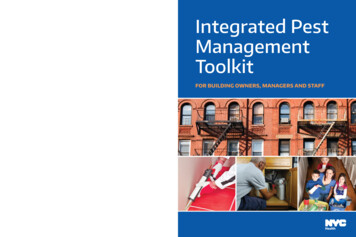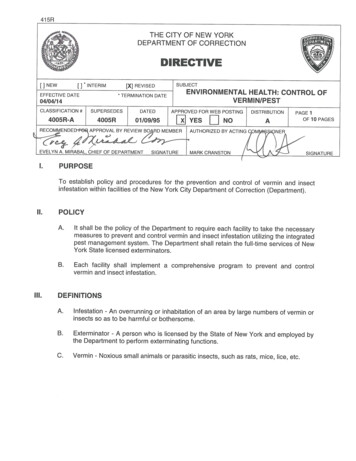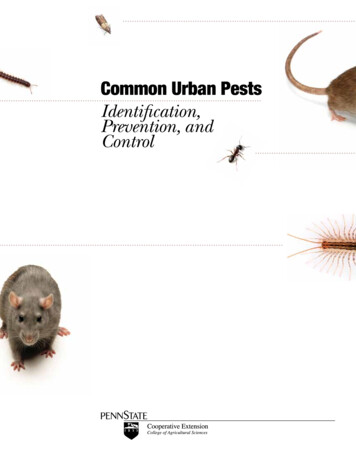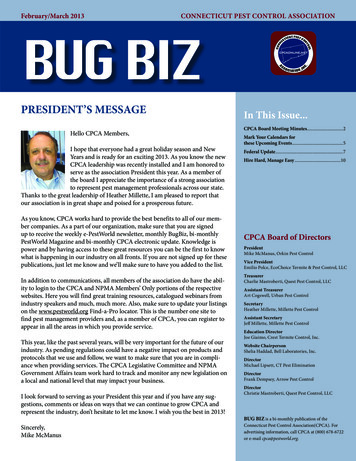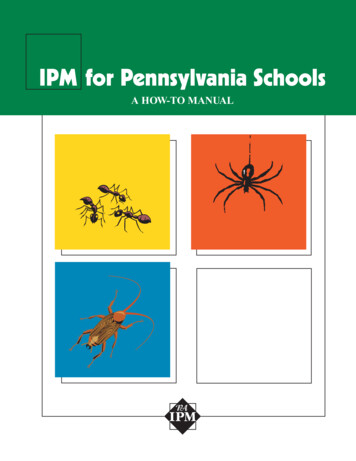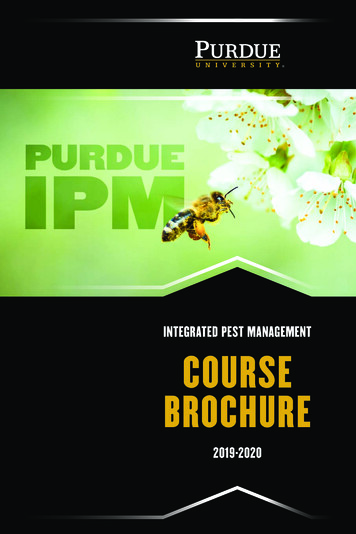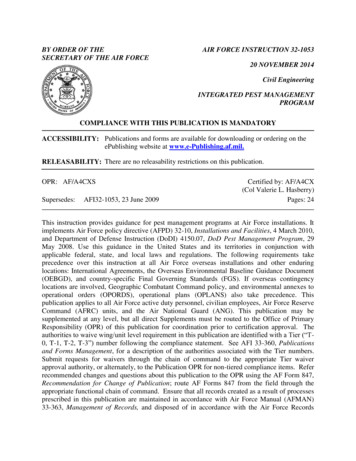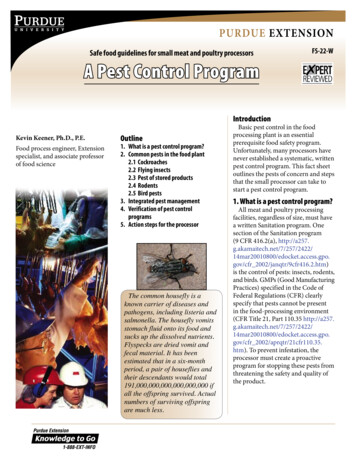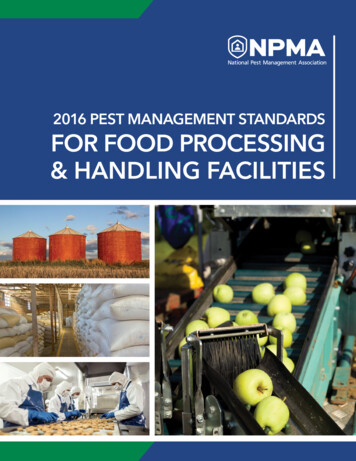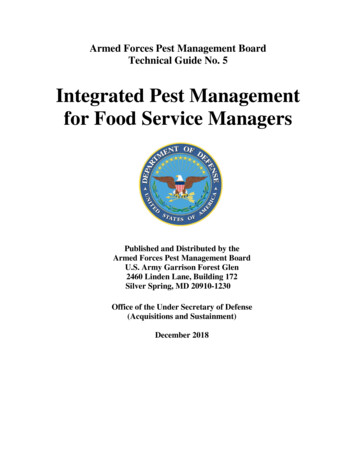
Transcription
Armed Forces Pest Management BoardTechnical Guide No. 5Integrated Pest Managementfor Food Service ManagersPublished and Distributed by theArmed Forces Pest Management BoardU.S. Army Garrison Forest Glen2460 Linden Lane, Building 172Silver Spring, MD 20910-1230Office of the Under Secretary of Defense(Acquisitions and Sustainment)December 2018
Table of Contents1. Armed Forces Pest Management Board .11.1 Technical Guides .11.2 Acknowledgements .11.3 Disclaimer.12. Intended Audience .23. Introduction .24. Integrated Pest Management (IPM) .24.1 Is There A Need For Pest Management?.24.2 Traditional Versus IPM .34.3 What Is IPM? .44.4 Steps of an IPM Program .45. DoD Food Service Pest Management.65.1 Installation Pest Management Plan.65.2 Who Are The Team Players?.75.3 Players Responsibilities .75.4 Components of a Food Service IPM Program.86. Common Items Used in an IPM Program .106.1 Equipment .116.2 Chemicals.196.3 Communications .207. Pests Associated with Food Service.247.1 Cockroaches .247.2 Flies.277.3 Rodents .297.4 Stored Product Pests .307.5 Occasional Invaders .348. Common Pitfalls in Food Service Pest Management .348.1 Structural .358.2 Sanitation .388.3 Clutter.418.4 Cultural .428.5 Surveillance .438.6 Control Measures .448.7 Communications .468.8 Follow-Up .469. Pest Management Regulations .469.1 Federal .469.2 Air Force .479.3 Army .479.4 Marines .489.5 Navy .48AppendicesA. Commercial Kitchen Pest Management Service Report Form . A-1B. Pest Sighting Log Form. B-1iii
1. Armed Forces Pest Management BoardThe Armed Forces Pest Management Board (AFPMB) recommends policy, provides guidance,and coordinates the exchange of information on all matters related to pest managementthroughout the Department of Defense (DoD). The AFPMB's mission is to ensure thatenvironmentally sound and effective programs are present to prevent pests and disease vectorsfrom adversely affecting DoD operations.1.1 Technical GuidesThis is one of a series of Technical Guides (TGs) published by the Information ServicesDivision (ISD), AFPMB. The AFPMB is a directorate within the Office of the AssistantSecretary of Defense for Energy, Installations and Environment that recommends policiesand procedures, provides guidance, and coordinates the exchange of information relatedto pest management throughout the DoD. The ISD Collects, stores and disseminatespublished and unpublished information on arthropod vectors and pests, natural resources,and environmental biology important to the DoD. Other ISD products include country- orregion-specific Disease Vector Ecology Profiles (DVEPs). All TGs and DVEPs areavailable at the AFPMB Web site, http://www.acq.osd.mil/eie/afpmb.TGs are not policy documents; rather, they provide technical guidance for the use of theDoD pest management community and others. Accordingly, TGs should not be construedor referenced as policy, unless cited in a policy document. DoD pest managementpolicies may be found in DoD Directive 4715.1E, “Environment, Safety, andOccupational Health,” and DoD instruction 4150.07, “DoD Pest Management Program,”,and component implementing directives, instructions, or regulations.Inquiries, comments or suggestions for improving TGs may be directed to the Chief, ISD,at (301) 295-7476, FAX: (301) 295-7473.1.2 AcknowledgementsThis Technical Guide was prepared by Mr. James Butler, US Army Public HealthCommand–Atlantic, Fort Meade, Maryland. Members of the AFPMB InstallationAdvisory Committee and the AFPMB staff have reviewed this document. Special thanksgo to Jim Harrison, Anne Radavich, Jerold Spohn, Dr. Doug Burkett and many otherswho contributed to the development, review, and improvement of this TG.1.3 DisclaimerTrade names are used in the TG to provide specific information or examples, and do notimply endorsement of the particular items or products named, or any criticism of similarones not mentioned. Any reference to trade names does not constitute a guarantee orwarranty of the products by the author, the AFPMB, the Military Services, or the DoD.1
2. Intended AudienceThis technical guide is written to help food service managers understand modern Integrated PestManagement and identify the characteristics of an affective program. Most food servicemanagers do not have pest management background, so this technical guide defines pestmanagement, details the roles and responsibilities of all major players, and provides guidance oncommon issues in food service pest management. This document will enable the reader to usethis information to improve their own program.3. IntroductionPest management in food service locations is a top priority for the U.S. military. Improper foodservice sanitation and poorly maintained facilities promotes pest infestation, and increases therisk of food-borne illness for Soldiers, Sailors, Airmen, Marines, their families, and other facilitypatrons. Effective pest management requires cooperation between many people and is not thesole responsibility of pest management professionals. This document covers the roles andresponsibilities of key personnel, provides an overview of pest management practices in foodservice locations, and allows the reader to understand their own role ensuring patrons areprovided safe and wholesome food.4. Integrated Pest Management (IPM)4.1 Is there a need for pest management?Food service locations are responsible for providing safe food to their customers. Thisprocess incorporates many food safety factors, from proper temperature and storage, tosanitary preparation and service. Pest infestations at food-service locations cancontaminate customers' food and damage the facility’s reputation. Pests will often walkfrom unsanitary surfaces, such as the floor, directly onto food or food-contact surfaces.This behavior increases the risk of food-borne illness through cross-contamination. If leftunchecked, a minor pest infestation can become a major infestation, increasing risks topatrons and staff at the food service location.An affective integrated pest management program identifies conducive conditions forpest infestations and works with the appropriate personnel to remove or reduce theseconditions appropriately. Additionally, routine monitoring and inspection can identifypest infestations earlier, when they are easier to control and have not placed patrons atrisk. These practices help reduce food service pest hazards and decrease the risk of foodborne illness.4.2 Traditional Pest Management versus IPMDoDI 4150.07 mandates that IPM methods be used on all DoD-owned property. Manypeople are unaware of the benefits of IPM and how it differs from traditional pestmanagement methods. All major players in food service pest management should2
understand the differences between the two approaches. The general mindset of these twomethods is outlined below.Traditional Pest Management: Encourages personnel to apply pesticides when no pests are present.Stresses using liquid pesticides around baseboards and in other locations toprevented infestations.May or may not use monitors and visual inspections.Applies pesticides as the primary control method, including using extensive liquidapplications or fogging.Does not emphasize non-chemical controls such as sanitation and decluttering.Integrated Pest Management: Forbids pesticide application when no pests are present.Uses visual inspections and monitoring to identify problems and evaluate controlmethod success.Selects the most effective tools to achieve long-term control.Controls pests using multiple methods, including improving sanitation, modifyinghabitats, repairing buildings, and changing human behaviors before resorting tochemical applications.Traditional pest management thinking remains prevalent in the food service industrytoday. Food service workers expect pest management personnel to come in and “spray”to solve any pest problems, and often overlook their own responsibilities in the process.This is antiquated thinking and often leads to unnecessary pesticide exposure and futurepest occurrences.Figure 1. Comparison of non-IPM focused (disorganized, overstocked, inaccessible) and IPM-focused(clean, well-organized, easily accessible) storage areas. Photo courtesy of James Butler, PHC-Atlantic3
4.3 What is Integrated PestManagement?Integrated Pest Management is a sciencebased approach that reduces pestpopulations through a variety of controlsfocusing on surveillance, prevention, andmost effective/lowest risk treatmentmethods. Control measures fall under fourbroad categories: cultural,physical/mechanical, biological, andchemical control. Cultural controls reducepest occurrence by modifying people’sbehaviors in the environment, such askeeping exterior doors closed or cleaningunderneath kitchen equipment.Physical/mechanical controls modify thefacility to reduce movement into—orharborage within—the structure, such asdoor sweeps and caulking. BiologicalFigure 2. A high-powered flashlight helpscontrol uses organisms to feed on pests orilluminate voids and openings during inspections.reduce favorable conditions, such as the use Photo courtesy of James Butler, PHC-Atlanticof bacterial agents to break down organicmaterial. Chemical control uses pesticides to kill or deter pests.For a more in-depth discussion of IPM, refer to AFPMB Technical Guide #29,“Integrated Pest Management In and Around Buildings.”4.4 Steps of an IPM ProgramEvery food service location is different, but the basic steps of an IPM program remain thesame. There are six fundamental steps to an effective IPM program, and if any one stepis not performed adequately, then the program may fail. The following describes eachstep in the IPM program:a. Surveillance: The first step is to assess the current state of the facility. A typicalpest management service begins with a visual inspection of the location. Thetechnician inspects to identify pest activity, find issues that might contribute topest infestations, and determine appropriate actions. Often times, supplementarymethods, such as insect monitors and staff interviews, are used to help determineif there are any ongoing issues within the facility.b. Identification: Identifying pests is of utmost importance when the technicianfinds evidence of pest presence. A cockroach is not just a cockroach, and an antis not just an ant. Each species has unique behaviors and characteristics that mustbe taken into consideration when determining effective control strategies. It is4
easy to identify pests when they are seen during inspection, but much harder whenonly evidence of pest activity is present, such as gnaw marks on a food container,or droppings (fecal material).c. Prevention: An ineffective IPM program waits for pest infestation to occurbefore taking action. By that point, patrons and staff are already at risk, and thecosts to control the infestation can skyrocket depending on the extent of theinfestation. Effective IPM programs continually use surveillance to identifyenvironmental conditions or cultural behaviors that contribute to pest infestations.Modifying the environment and cultural practices to reduce pest harboragelocations or food sources can stop an infestation before it starts, thus not onlyreducing the risk, but eliminating it.d. Treatment: Despite a program's best efforts, pests may still infest a facility.When this occurs, treatments are necessary to remove the pest and associatedrisks. Chemical treatments are only one option within an IPM program. In fact,chemicals are usually the last resort, and successful programs focus on preventivemeasures and non-chemical methods such as traps and exclusion first. Pestsshould be identified and targeted using the lowest risk, most effective method toachieve control.e. Reporting and Documentation: It is essential to document deficiencies, pestpresence, and control measures performed at each service, and to convey thatinformation to the appropriate stakeholders. Pest control technicians, PreventiveMedicine, and Veterinary Services should provide documentation directly to theFood service manager after each service. Sharing the inspection findings amongall the players will help identify issues and get them corrected early.f. Evaluation: An IPM program is not step-by-step recipe with a finished product.Each step in the IPM program is an ongoing process and each process needs to becontinuously reevaluated to ensure it is working properly. The evaluation stage iswhere an IPM program adapts to the dynamic environment of a dining facility.Evaluation may show that traps or monitors should be moved to better locationsbased upon the current needs. Pest services may need to shift priority to adifferent area while prevention and treatment activities are occurring. Facilityrequirements vary from day to day, and all players need to evaluate the currentneeds and adapt their responsibilities to support a successful IPM program.5. DoD Food Service Pest ManagementPest management on a DoD facility may differ greatly from the private sector. In the privatesector, laws and regulations governing pest management operations are minimal, focusingprimarily on public safety and not on sound IPM practices. While the pest management industryhas established best practices, there is no governing force that ensures pest managementcompanies follow these guidelines. Private sector pesticide applicators are not required to follow5
a specific facility management plan unless agreed upon by both the company and theircustomers. In contrast, pesticide applicators working in a DoD facility are held to strictstandards set forth by a formal IPM plan.For further guidance on DoD-specific IPM programs, refer to AFPMB TG 18, “Installation PestManagement Program Guide.”5.1 Installation Pest Management PlanAll DoD installations must have an approved and implemented Installation PestManagement Plan (IPMP). This plan establishes the roles and responsibilities of keypersonnel involved with installation pest management operations. It also includesspecific documentation requirements, approved pest management operations procedures,safety guidelines, and installation-specific concerns. The IPMP is intended to be a livingdocument with up-to-date information on both who and how all pest management isconducted at that location.5.2 Who are the team players?Effective IPM in a food service location involves many players. Primary players includethe Food Service, Facilities Maintenance, and Pest Management personnel. Secondaryplayers include public health assets, Quality Assurance Evaluators (QAE), third-partyauditors, equipment-maintenance personnel, food-delivery personnel, and patrons. All ofthese personnel must work cooperatively for a pest management program to be effective.5.3 Players’ Responsibilitiesa. Integrated Pest Management Coordinator (IPMC): The IPMC oversees allpest management operations at the installation. They compile all pesticideapplication records and send them to the AFPMB for archiving. They maintainthe approved pesticide list and evaluate requests to use novel pesticides on theinstallation.b. Food Service: Food service personnel are responsible for preparing, cooking, andserving safe food to the customers. To do this, they must maintain a cleanenvironment and are therefore ultimately responsible for the cleanliness of thefacility, either through a dedicated cleaning crew or by personally cleaningbetween food preparation and service activities.c. Pest Management: Pest management technician inspects the facility for pests orpest evidence, identify contributing or conducive factors leading to pestinfestations, and recommend or conduct treatments to reduce or prevent pestinfestations. An efficient pest management technician identifies problems andcommunicates corrective actions to the appropriate personnel. They are the soleentity allowed to apply pesticides in the facility if chemical treatments arewarranted.6
d. Facility Maintenance: The installation public works or civil engineers areresponsibility for all building maintenance and repair. Most installations utilize awork order-based system where service requests are made through phone call oran online portal. Once a work order has been generated, appropriate facilitiespersonnel are notified and the request is fulfilled. Facilities personnel mayconduct periodic scheduled inspections of the buildings to identify and correctemerging issues before they become a problem. If this does not occur, a servicerequest should be generated when food service, public health, or veterinaryservices personnel identify an issue.e. Public Health: Installation public health assets ensure food safety. They conductmonthly facility inspections for proper food handling practices, facility sanitationand repair, pest management, and other practices that affect the wholesomeness offood. Public health assets may also conduct food handing and safety courses, andcoordinate with the key players when issues arise.f. Quality Assurance Evaluator (QAE)/ Contractor Officer Representative(COR): A QAE/COR oversees the work of contracted pest control services. Inmany instances, the QAE/COR is the signature authority for services rendered andmay work in a different building. They ensure contract compliance and shouldconduct on-site inspections of pest management contracted services.g. Veterinary Services: Veterinary food inspectors oversee food safety fromproduction through final storage. They conduct inspections to ensure the food iswholesome, unexpired, and without pest infestations. When food is found to beunsafe, inspectors will condemn the affected products and recommendremediation if needed.For further guidance on food condemnation levels, refer to MIL-STD-904C,“Department of Defense Standard Practice: Detection, Identification, andPrevention of Pest Infestation of Substance.”5.4 Components of a Food Service IPM Programa. Building Structural Integrity and Pest Exclusion: A primary IPM preventivemeasure is ensuring the building is structurally sound and that pests are excludedfrom potential entry points including pipe chases, door thresholds, windows, andother structural entryways. All buildings fall into disrepair over time. When7
structural components wear outor get damaged, it is imperativeto submit a work order to correctthese deficiencies. A seeminglyinsignificant hole can provideentry into wall voids, wherecockroaches can harbor andbecome an infestation. A waterleak can degrade floor tiling,which accumulates food debrisand becomes a food source forpests. These issues should beaddressed as soon as they arediscovered. Work orders shouldbe submitted and followed up onto ensure the work is completed.Figure 3. Hole chewed in drywall by mice. Photocourtesy of James Butler, PHC-Atlanticb. Environmental Sanitation: Poor sanitation practices are the number one cause ofpest infestations. When a facility is unsanitary, organic material builds up,providing an attractive food source for pests. Certain control measures, such asinsecticidal baits, are ineffective when other food sources are readily available topests. Why would acockroach eat baitwhen they have asmorgasbord of tastyfood debris throughoutthe facility? Goodsanitation practices areessential and shouldinclude daily, weekly,and monthly cleaningprograms to ensure allareas of a facility arecleaned on a routineFigure 4. Dirty sink strainer risks contaminating frozen shrimp withbasis.pathogens. Photo courtesy of James Butler, PHC-Atlanticc. Cultural Behaviors: Personal behaviors can unintentionally let pests intofacilities and allow them to persist. Pests have easy access to a building throughopen and unattended doors or windows. It is surprising just how many will walkright through an unattended back door. Harborage locations are created whenunnecessary items are stored in a disorganized manner, providing homes for peststo proliferate. Cluttered areas are often not cleaned adequately or inspectedproperly for pests. Keeping doors closed when not in use, decluttering, andkeeping exterior lights off when unnecessary can make facilities less attractive topests and reduce the chances they will enter facilities.8
d. Pest Surveillance: Pest surveillance can be divided into two categories: visualsurveillance, and monitoring. Visual surveillance is analogous to taking aphotograph: it is a snapshot of what is occurring at the time of the inspection.Pest monitors are analogous to a video camera because they are constantlymonitoring the situation. Monitoring can be sub-divided into two methods: longterm and short-term. Pest management companies prefer to use continuous, longterm monitoring, which is when monitors are checked for pest presence duringeach service. Alternately, preventive medicine inspectors usually employs shortterm, threshold-based monitoring. They use precise timeframes and thresholdlimits to determine the extent of an infestation and decide if control measures arenecessary.e. Reducing Conducive Conditions: All players involved should documentconducive conditions and report them to the appropriate personnel forremediation. Building disrepair, sanitation deficiencies, and poor culturalpractices all contribute to pest presence and correcting these issues in a timelymanner reduces the potential for new infestations. A bulk of the time in a highfunctioning IPM program is devoted to surveying for and reducing factors thatcontribute to pest infestations. In contrast, a poorly run IPM program ignores thiscomponent in favor of treating infestations as they develop.f. Chemical Control: Chemical control should only be used as a last resort in DoDfood service locations. NO ROUTINE PREVENTIVE CHEMICAL CONTROLis allowed on federal facilities. Unlike commercial pest control in the civiliansector, where routine preventive applications are common, federal facilities use anIPM approach and only use chemical control when pest are present.g. Follow up: Follow-up surveillance and inspections are essential components of apest management program. Adjusting the monitoring program can enhance itseffectiveness. Assessing chemical and non-chemical control measures ensures theprogram is effective and provides valuable information about pest harboragehotspots and provides insight as the effectiveness of control measures. You cannotdetermine if a control measure was effective without proper follow-up. Inessence, follow-ups tie the program into a continual cycle of good pestmanagement practices.h. Public Health and Veterinary Services Inspections: Public health andveterinary service assets conduct extensive inspections of your facility and shouldbe providing feedback on conducive pest conditions. As with pest managementservice reports, you should be notified of the results of these inspections and anydeficiencies that need to be addressed.9
6. Common Items Used in an IPM ProgramThe pest management industry has a wealth of available equipment and materials tomanage pests. From time-tested to state-of-the-art, these devices come in all shapes, sizes,and functionalities. The breadth of available equipment is too wide to cover in onetechnical guide, so the following sections provide generic descriptions of commonequipment used in a food service IPM program.6.1 EquipmentPest management personnel employ traps, monitors, and exclusionary devices withinfood service establishments. The following items are commonly used in an IPMprogram.Figure 5. Insect monitor with German cockroaches. Inspecting trap catches can indicatethe severity of the infestation and suggest the direction of the infestation source. Photocourtesy of James Butler, PHC-Atlantica. Monitoring: Monitoring devices, commonly some sort of passive sticky trapcome in a variety of shapes and sizes, but they all have the same basicfunctionality, a substrate with adhesive designed to capture pests. Insect monitorsshould not be used as a method for control, they are used as part of a strategicplan to identify pest infestations early and gain insight on their presence andlocation within the facility. These are placed in areas where the target pest islikely to be found and inspected/replaced at each service. Depending on pest,10
monitors should be placed parallel with walls or other structural edges thatcommon pests use during foraging activities. The adhesive effectivenessdiminishes over time due to dust or other contaminants and must periodically bereplaced.Figure 5. Insect monitor placed underneath sink where suspected cockroaches wereharboring. Correct placement is key for early detection of infestations. Photo courtesy ofJames Butler, PHC-AtlanticWhereas visual inspectionsare much like taking aphotograph of the situation,monitoring devices functionmuch like a video camera,continually recording datawhen present. These devicesshould be dated when initiallyplaced out and again at eachservicing. Longevity of thedevice is valuable informationand should be noted whenassessing the overall pestFigure 6. Insect monitor without proper dating. Photosituation.courtesy of James Butler, PHC-Atlantic11
There are two approaches to insect monitoring used in a food service location andit is important to distinguish between the two. The first, and most commonstrategy, is the continual use method. This is typical of pest control, wheremonitors are left out indefinitely and inspected for activity at each service.Monitors used in this manner help to identify pest infestations early. The secondmethod is a threshold test. This method is typically used by preventive medicineassets and involves placing insect monitors out for a set amount of time, usually24 hours, and comparing the number of captured pests to a threshold level. If thelevel is exceeded, it justifies treatment.Twenty-Four Hour German Cockroach Trap ThresholdsLess than 1 cockroachp
An affective integrated pest management program identifies conducive conditions for pest infestations and works with the appropriate personnel to remove or reduce these conditions appropriately. Additionally, routine monitoring and inspection can identify pest infestations earlier, when they are easier to control and have not placed patrons at .
